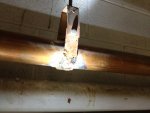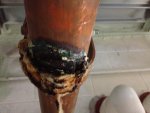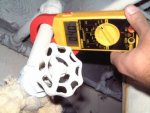Fellow members I have an unusal corroding copper water pipes in a crime lab that i can't explain I have included photos. The lab has chemicals but thay are contained in vent hood enclosures. The corrosion isn't in a continous run they are in the middle and on fitings (90*) and where strap hangers not dissimilar metal. Building grounds, water pipe grounding and fire sprinklers are to code. This is happening under insulated piping as well as exposed copper. Has enyone experienced anything like this? Thanks !
You are using an out of date browser. It may not display this or other websites correctly.
You should upgrade or use an alternative browser.
You should upgrade or use an alternative browser.
Electrolysis or Not?
- Thread starter DonP520
- Start date
- Status
- Not open for further replies.
- Location
- Placerville, CA, USA
- Occupation
- Retired PV System Designer
Either you have dissimilar metals or the suspending rod anchored to the concrete is carrying current, possibly DC.
I would isolate the pipe from the hanger with an insulator and then measure for potential difference which may be less than a volt.
If you can characterize the voltage you may have a clue to its source.
Sent from my XT1080 using Tapatalk
I would isolate the pipe from the hanger with an insulator and then measure for potential difference which may be less than a volt.
If you can characterize the voltage you may have a clue to its source.
Sent from my XT1080 using Tapatalk
mgookin
Senior Member
- Location
- Fort Myers, FL
- Occupation
- Retired inspector, plans examiner & building official
Even if they're both copper, they could be different grades of copper.
Over what time span did this happen?
Seems to me they need a plumber and the plumber should put a barrier between the pipe and the hanger, something like a rubber pad should do it.
Over what time span did this happen?
Seems to me they need a plumber and the plumber should put a barrier between the pipe and the hanger, something like a rubber pad should do it.
ghostbuster
Senior Member
- Location
- Great White North
We have had several large commercial and condo buildings with 30 to 40 amps of current on the copper water piping.
It required a long investigation to find all the current sources flowing onto this piping system.A lien was also issued.
Good Luck
It required a long investigation to find all the current sources flowing onto this piping system.A lien was also issued.
Good Luck
ATSman
ATSman
- Location
- San Francisco Bay Area
- Occupation
- Electrical Engineer/ Electrical Testing & Controls Retired 2025
We have had several large commercial and condo buildings with 30 to 40 amps of current on the copper water piping.
It required a long investigation to find all the current sources flowing onto this piping system.A lien was also issued.
Good Luck
I agree. An old PQ engineer told me long ago...when t-shooting PQ issues, voltages can lie, currents do not.
Put a clamp-on AM around the pipe and you will find the answer.....
- Location
- Placerville, CA, USA
- Occupation
- Retired PV System Designer
And for completeness, be sure to use a DC amp clamp!
Sent from my XT1080 using Tapatalk
Sent from my XT1080 using Tapatalk
gadfly56
Senior Member
- Location
- New Jersey
- Occupation
- Professional Engineer, Fire & Life Safety
Real Copper Hangers?
Real Copper Hangers?
Take a magnet to the pipe hangers. These hangers are usually copper-washed steel, not truly all copper. If the wash was mechanically damaged, allowing the steel to contact the copper, you may have your culprit.
Real Copper Hangers?
Take a magnet to the pipe hangers. These hangers are usually copper-washed steel, not truly all copper. If the wash was mechanically damaged, allowing the steel to contact the copper, you may have your culprit.
ptonsparky
Tom
- Occupation
- EC - retired
Nasty. At least it is on the outside and visible. Report back when you find the source.
brian john
Senior Member
- Location
- Kilmarnock, Va
- Occupation
- Retired after 52 years in the trade.
What I would do.
Measure AC and DC current at each location
Main service neutral to ground bond
All transformers neutral to ground bond
All DC systems ground bond
Generator (check for 4 pole ATS if the generator neutral is grounded at the Gen Set.
Then measure current on the water pipes
I have done quite a few of these and we found AC neutral ground current (never found DC issues) in each case yet the problems persisted, turned out it was chemical treatment in a few cases and the others were dissimilar metals.
Measure AC and DC current at each location
Main service neutral to ground bond
All transformers neutral to ground bond
All DC systems ground bond
Generator (check for 4 pole ATS if the generator neutral is grounded at the Gen Set.
Then measure current on the water pipes
I have done quite a few of these and we found AC neutral ground current (never found DC issues) in each case yet the problems persisted, turned out it was chemical treatment in a few cases and the others were dissimilar metals.
jxofaltrds
Retired ESI
- Location
- Mike P. Columbus Ohio
- Occupation
- Creator
ATSman
ATSman
- Location
- San Francisco Bay Area
- Occupation
- Electrical Engineer/ Electrical Testing & Controls Retired 2025
Ground Currents or Net Currents
Ground Currents or Net Currents
I think the important thing to take from this discussion is:
Ground wires, EGC, water pipes, conduits, any building steel, etc should not be conducting any continuous current except during a fault or if a circuit is not wired correctly. Anyone to disagree?
Ground Currents or Net Currents
I think the important thing to take from this discussion is:
Ground wires, EGC, water pipes, conduits, any building steel, etc should not be conducting any continuous current except during a fault or if a circuit is not wired correctly. Anyone to disagree?
jxofaltrds
Retired ESI
- Location
- Mike P. Columbus Ohio
- Occupation
- Creator
I think the important thing to take from this discussion is:
Ground wires, EGC, water pipes, conduits, any building steel, etc should not be conducting any continuous current except during a fault or if a circuit is not wired correctly. Anyone to disagree?
LOL. NO. Only objectionable current.
Some current is know to be there and is not a violation.
Watch some of our host's videos.
- Location
- Illinois
- Occupation
- retired electrician
If you have included grounding electrode conductors in that list, I disagree. Grounding electrode conductors are part a parallel path for the grounded conductor and will almost always have some current. (just not sure what your term "ground wires" means)I think the important thing to take from this discussion is:
Ground wires, EGC, water pipes, conduits, any building steel, etc should not be conducting any continuous current except during a fault or if a circuit is not wired correctly. Anyone to disagree?
The same can also occur with EGCs. The are connected to the grounded conductor via the main bonding jumper and if they make contact with the earth or conductive item that is connected to the earth, there will be the same parallel path as with the GEC.
ATSman
ATSman
- Location
- San Francisco Bay Area
- Occupation
- Electrical Engineer/ Electrical Testing & Controls Retired 2025
Ok, I stand corrected :ashamed: What we are talking about here is a matter of degree. I was thinking in a perfect world. Since there is no such thing as perfect insulation there will always be some ground leakage or "net" currents in the grounding system. It is a matter of knowing HOW MUCH IS LEAKING. The rule of thumb I always went by was that if the current was over a few % of the main service load current then you should start investigating.
petersonra
Senior Member
- Location
- Northern illinois
- Occupation
- Semi-retired engineer
best quick fix is to have the plumbers come in and install some kind of electrical and physical isolation between the hanger and the pipe.
it may not resolve the cause but it will stop the corrosion and give you time to deal with the real cause which may or may not be electrical system in nature.
it may not resolve the cause but it will stop the corrosion and give you time to deal with the real cause which may or may not be electrical system in nature.
- Location
- Placerville, CA, USA
- Occupation
- Retired PV System Designer
Ok, I stand corrected :ashamed: What we are talking about here is a matter of degree. I was thinking in a perfect world. Since there is no such thing as perfect insulation there will always be some ground leakage or "net" currents in the grounding system. It is a matter of knowing HOW MUCH IS LEAKING. The rule of thumb I always went by was that if the current was over a few % of the main service load current then you should start investigating.
Well, yes and no. If the source of the GES current is really leakage to ground, then that leakage could just as well return to the POCO secondary neutral through the service neutral rather than to through the earth to the POCO ground.
And if there is any current at all in the building neutral, as a result of imbalance rather than leakage, then some portion of that current can return to the secondary neutral at the transformer by both the service neutral and the sum of the two ground impedances.
Under normal circumstances, most of the current will follow the wire path, by a factor of 100 or more.
If the service neutral is long enough and small enough that the voltage drop is significant, then the long range advantage of the flow through earth will start to show up.
IMHO, if the GEC current is a few percent of the neutral current, there is likely to be a problem, but it is more likely to be related to a high neutral impedance than to an abnormal source.
If the GEC current is a few percent of the phase current and the neutral current is small compared to the phase current, then I would call that a serious problem. But it is, in my first guestimate, more likely to be the result of a neutral problem at some other building on the same secondary if the service neutral of the building you are working on is solid.
- Location
- Illinois
- Occupation
- retired electrician
If there is a common metal underground water pipe used as a grounding electrode, it would not be unusual to find 20% or more of the grounded conductor current on the water pipe. If there is a problem with the service neutral, the pipe will often carry all of the grounded conductor current and the building occupant will not even know that there is a problem with the service neutral...until someone takes the water pipe apart.... The rule of thumb I always went by was that if the current was over a few % of the main service load current then you should start investigating.
brian john
Senior Member
- Location
- Kilmarnock, Va
- Occupation
- Retired after 52 years in the trade.
Ok, The rule of thumb I always went by was that if the current was over a few % of the main service load current then you should start investigating.
A few % of a 400 amp service would be .02x400=8 amps pretty high in my opinion
A few % of a 4000 amp service would be .02x4000=80 amps pretty durn high.
There are many factory that would affect this number, the size of the facility, wiring method utilized.
In a typical Washington DC 3000-4000 amp service, commercial building 12 stories, two risers, assuming all the neutrals are free of shorts to ground downstream from the main neutral bond, we see 2-12 amps on the main neutral ground bond.
Problem is few buildings we test have a distribution neutral that is clear of shorts downstream from the neutral bond.
Last edited:
cadpoint
Senior Member
- Location
- Durham, NC
- Occupation
- Electrician - but not by NC Law.
This is a good detective thriller.
Besides doing your investigations on some levels of current on the copper line, there's more too
this in my opinion. We see there's current to cause the collection of other elements!
Where the water line enters the building what is the condition there? First off your in TX, isn't the water heavy with iron?
The following are not your problems. Wether you want to even suggest any of the following is
beyond my level of pay!
If the building had pictures during construction note if the copper pipe was layed on the ground before installation.
The pipe need to be removed, the hanger needs to be replaced once done have both the inside if there is material build up and of course the outside of the effected areas, analogized by a chemist. The installer should change glooves between demo and install!
Also have the present water tested, asis, the drawn water should be tested with-in 24 hours.
To say that all the chemicals are underthe hood is to say ?a statement?.
Gases are released when changing bottles all the time. But I'm going to go one step further and
state the the problem started with the induction of solvents released during the construction of
the structure. It could be based on the paint they used! If they have this type of problem they might have gas problem with their hoods!
The job MSDS book will have items used during construction listing their properties that will match concentrations found in the sample of the scraping, or reqularly used in the lab.
As said the pipe just needs to sit on a piece of rubber in the sleeve suited for the environmental conditions. I'm surprised more care wasn't taken over all with copper in a "classified enviroment".
Besides doing your investigations on some levels of current on the copper line, there's more too
this in my opinion. We see there's current to cause the collection of other elements!
Where the water line enters the building what is the condition there? First off your in TX, isn't the water heavy with iron?
The following are not your problems. Wether you want to even suggest any of the following is
beyond my level of pay!
If the building had pictures during construction note if the copper pipe was layed on the ground before installation.
The pipe need to be removed, the hanger needs to be replaced once done have both the inside if there is material build up and of course the outside of the effected areas, analogized by a chemist. The installer should change glooves between demo and install!
Also have the present water tested, asis, the drawn water should be tested with-in 24 hours.
To say that all the chemicals are underthe hood is to say ?a statement?.
Gases are released when changing bottles all the time. But I'm going to go one step further and
state the the problem started with the induction of solvents released during the construction of
the structure. It could be based on the paint they used! If they have this type of problem they might have gas problem with their hoods!
The job MSDS book will have items used during construction listing their properties that will match concentrations found in the sample of the scraping, or reqularly used in the lab.
As said the pipe just needs to sit on a piece of rubber in the sleeve suited for the environmental conditions. I'm surprised more care wasn't taken over all with copper in a "classified enviroment".
Last edited:
- Status
- Not open for further replies.




